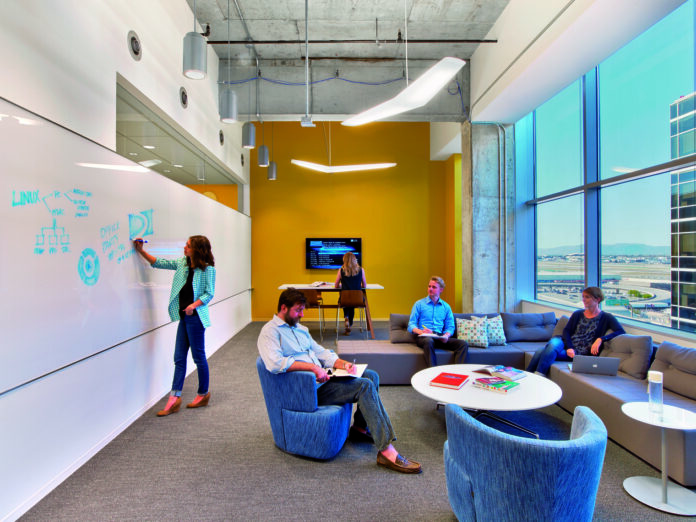Summary:
“Technology and the workplace are not separate entities. Collaborative technology is part of nearly every workflow, integrated into the fabric of how people communicate. At the same time, the modern workplace is sometimes at odds with itself. Designers are tasked with creating spaces that are flexible but consistent, support open collaboration but deep focus, promote innovation but enable execution. Oh, and they should include all the cool technology today’s employees expect.
Ultimately, to create spaces where workers use collaborative technology to accomplish their goals, designers, technology integrators, and employees should answer several questions. What is work? What is a meeting? What needs to be accomplished? How can people, space, and technology support the goals?
But even in those situations, meeting spaces can sit idle. And not every team in the organization works the same or requires the same tools. As a result, Keene says, Google is moving to a meeting space model based on team needs. The company is giving teams a “space budget”—physical floorspace in otherwise open work areas—where they can erect a company-provided, modular meeting space. As long as it’s deployed, the room belongs to the team. If for some reason the team doesn’t need the room anymore, it can be removed in 24 hours.
“We’ve been supplying modular meeting rooms that we can spin up and redeploy very quickly,” Keene says. “Within their space budgets, teams can say, ‘We want a four-person meeting room and a phone booth, please.’ They’re both [videoconferencing]-enabled and maybe the meeting room also has Jamboard [interactive display]….We’re trying to make meetings and ad hoc collaboration genuinely frictionless, while at the same time removing the problem of noise distraction in what are predominantly open-plan offices.”
In the U.K. Google office where Keene works, there are about 2,000 engineers and 150-plus modular meeting rooms deployed at any one time. They’re made of interchangeable, acoustically treated wood panels, with privacy glass and a door. The audiovisual technology is straightforward — one or two screens built into a wooden frame, with hardware and cables laid out neatly in a grid underneath and covered by a snap-on wooden credenza.
“When we designed the building, we designed a modular ceiling grid for any services that need to run into a meeting room,” explains Keene. “That means that data, power, and AC can just be snapped in.”
Analysis:
This article stresses the importance of designing around people rather then designing around technology. As co-working spaces are on the rise, Google attempts at creating modular spaces in order to fulfill the separate needs of each user. It aims to stray away from the notion that “technology lets employees meet anywhere.” and instead develop spaces based on analyzing how employees work, where that is individually, or collaboratively. This is more relevant to how I will conduct my primary research with co-design activities. This article inspires me to use co-design sessions that involve 2D and 3D spatial planning.
They end the article by saying, “As critical as technology is to the modern workplace, the spaces where people collaborate need to be designed around the work, not around the supporting technology. If anything, all the audiovisual systems associated with conferencing and collaboration need to disappear into the spaces they activate— or, when not needed, altogether.” This is very relevant to the problem space because I definitely was getting lost in the ‘techy’ parts of the DESIS Lab; wondering how the technology itself could be supported. It is important to put people at the center of the design, understanding how people will move about the space is key to designing an efficient space.
Source:
Grimes, B. (2020, March 9). Nowhere to meet? how google and others are changing how workers collaborate. Work Design Magazine. Retrieved September 8, 2022, from https://www.workdesign.com/2020/03/how-google-and-others-are-changing-collaborative-technology/




